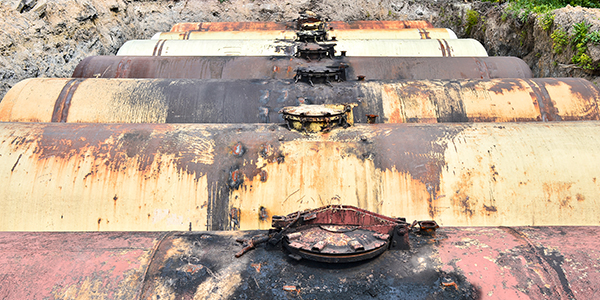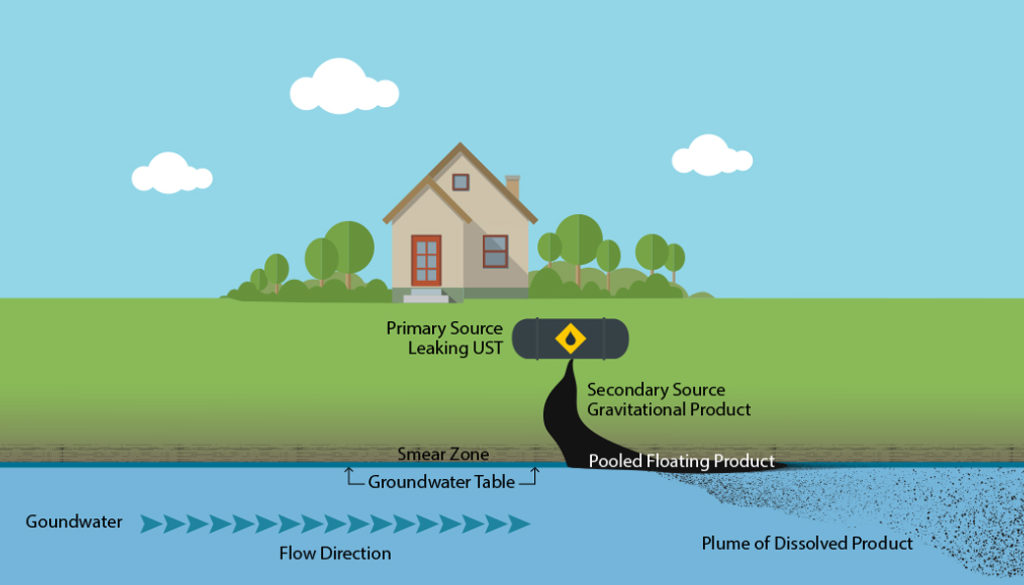
18 Jan Groundwater Contamination: Reducing the Time and Expense of Site Remediation
Environmental consultants know that groundwater remediation is potentially more lucrative than soil remediation. Thus, it is imperative that you select an environmental consultant who will work in your best interests to minimize the time and cost of site remediation. In part two of this three-part series, ESA shares some of the more common groundwater remediation methods and strategies that can accelerate remediation or even eliminate long-term remediation altogether.
Groundwater Terminology
One of the most common sources (but by no means the only source) of groundwater contamination is a leaking underground storage tank (UST). For the purposes of this article, let’s assume that a UST is leaking heating oil, an organic liquid with a specific gravity of less than 1 (meaning that it floats on water). Let’s also assume that the geology is unconsolidated — that is, the subsurface is comprised of sands, silts, clays and gravel — or some combination of those materials — underlain by bedrock. Depending on where the site is located, the thickness of unconsolidated materials can range from less than a foot or two to several hundred feet. Most (if not all) of the environmental impacts will exist above the bedrock. The following terminology and diagram will help illustrate this scenario:
Primary source: The point of origin for the impacts. In this illustration, it is a leaking UST.
Secondary source: If the UST leaks for some time, the oil will migrate (i.e., percolate) downward through the soil via gravity. This mass of free product slowly travels downward and is absorbed into the soil, creating a secondary source.
Water table: The surface (upper most) layer of groundwater.
Smear zone: Because water table elevations fluctuate seasonally, the water table has elevational low and high points. The vertical area through which the water table’s elevation fluctuates is called the smear zone. Product (either as a pool or plume (see more definitions below)) floating on the water table will continually contaminate the smear zone as the groundwater elevation fluctuates.
Pool: The thin layer of product (in this case heating oil) floating on the water table
Plume: Almost all liquid organic substances dissolve in water to some degree, including oil. The pool of product, due to its viscosity, tends to move through the groundwater slowly. However, the dissolved portion, or plume, moves at the same velocity as the water table and will therefore move faster than the pooled liquid.

Removal of Primary and Secondary Sources of Groundwater Contamination
The first and most important step in groundwater remediation is to eliminate the primary source of contamination. Once the primary source is gone, the secondary source must also be remediated. Failure to do either guarantees an ongoing — and potentially worsening — groundwater contamination issue.
Removal of Pooled Free-Floating Contaminated Product
After removal of the primary and secondary sources of contamination, any remaining free-floating product must be addressed. In a previous article entitled Easier Groundwater Remediation, we discuss the most efficient and effective ways to tackle free-floating product encountered during the tank removal process. But what if pooled floating product is discovered long after a tank is removed?
As described in Easier Groundwater Remediation, ESA recommends first excavating the overlying soil (overburden) to expose the pooled product. This allows for the simultaneous removal of the pooled product as well as the impacted soil in the smear zone. But when this remedial method is not feasible (e.g., if the tank lies below a building, or there are structural concerns, or if the tank is in close proximity to subsurface utilities), it may be preferrable to use a technique called EFR.
EFR (Enhanced Fluid Recovery) utilizes a vacuum truck to remove the pooled product through one or more wells drilled for this purpose. The process, which is typically performed over several days spaced a week or two apart, results in the extraction of a large amount of groundwater along with the pooled product. If the pooled product is not too abundant and the water-bearing soil is not primarily fine-grained material (i.e., silts and clays), EFR may solve the problem or, at a minimum, it will significantly reduce the volume of product. If, however, EFR cannot adequately address the issue, then it may be advisable to install recovery wells with skimmers or a product recovery gallery/trench.
Addressing the Remaining Contaminated Product Plume
Once the pooled floating product is completely removed, the plume must be addressed. Given enough time, and assuming the primary and secondary sources have been eliminated, the plume’s concentration will gradually diminish. As such, project closure can be achieved by designating the site as a Classification Exception Area (CEA) via MNA (Monitored Natural Attenuation). This NJDEP-sanctioned method permits closing a case where residual contamination is present by allowing long-term monitoring of the plume in lieu of active remediation. Over time, the goal is to generate analytical results from the monitoring wells that demonstrate decreasing contaminant concentrations.
Impacts on Bedrock and other Groundwater Contamination Scenarios
Thus far, we have discussed groundwater impacts in unconsolidated geology. But what if the impacts have invaded bedrock? Bedrock impacts create an entirely new and more complex set of issues that often require a more expensive and time-consuming remedial effort. This deeply complex issue cannot be sufficiently addressed in a single article. If you have questions or concerns about environmental impacts on your property, we encourage you to Ask ESA.
Groundwater Remediation Key Strategies
Given all that we have discussed here, there are two strategies to keep in mind: First, whenever possible, postpone the installation of monitoring wells. If wells are installed soon after removing the source or pool, then it is likely that the water quality samples will be highly impacted. But if well installation can be deferred for six months or so, you increase the likelihood of more favorable sampling due to natural attenuation. Second, be 100% certain that the impact is not originating from an off-site source before investing in the cost of remediation. Property owners are not responsible for remediating impacts that originate from an adjoining site. They are responsible, however, for producing multiple lines of evidence to prove that the impacts are not coming from their property. The experts at ESA can help you analyze the evidence and provide you with the most cost-effective and efficient mode of resolution to your unique situation.



